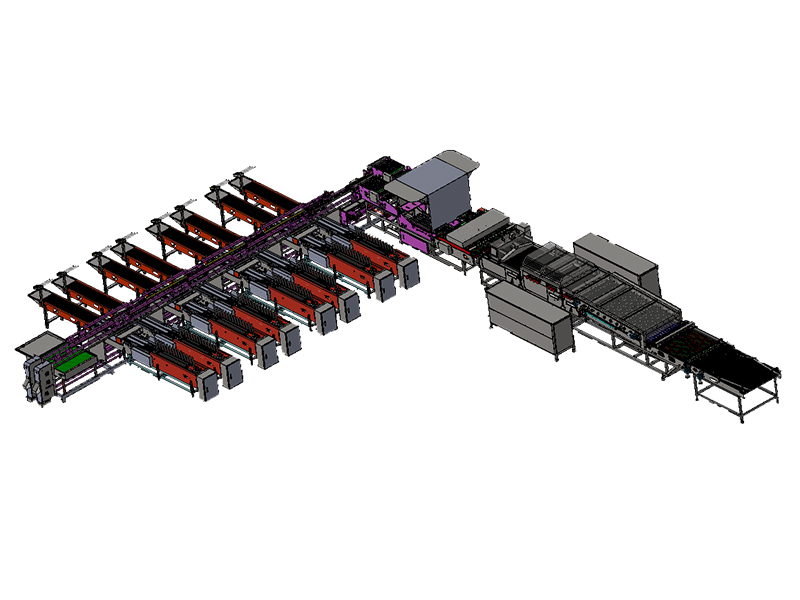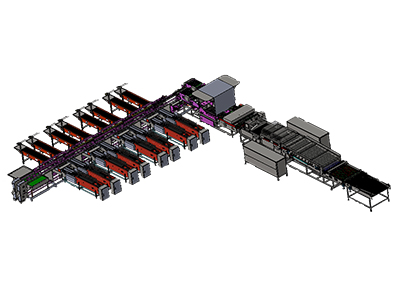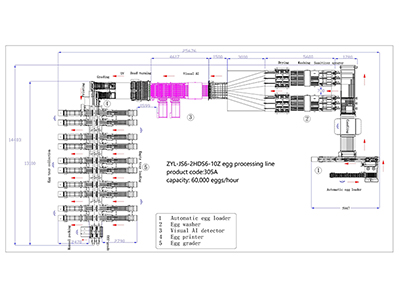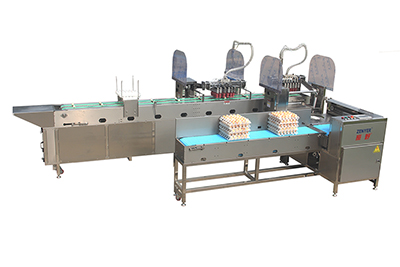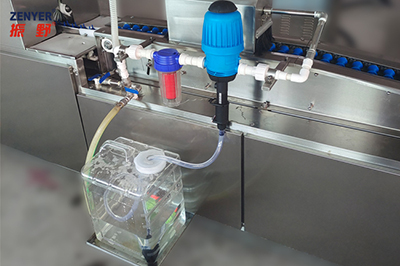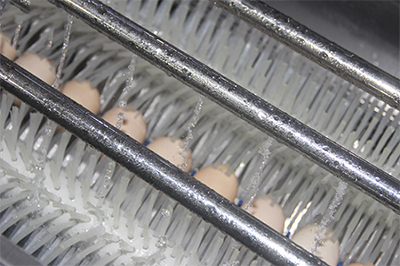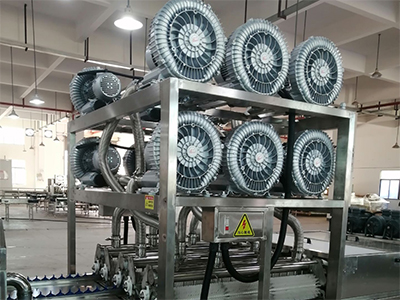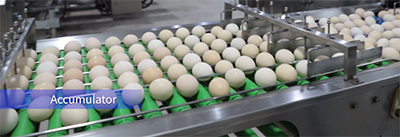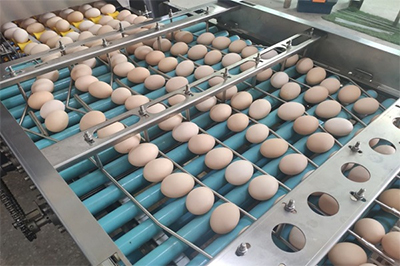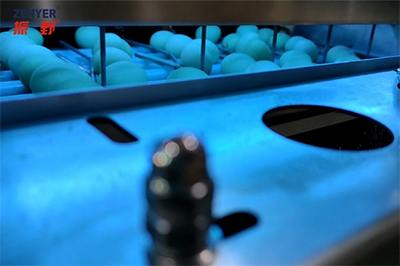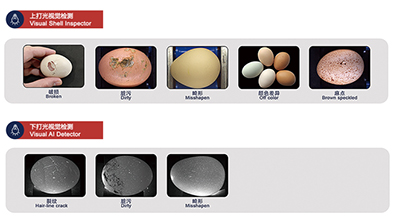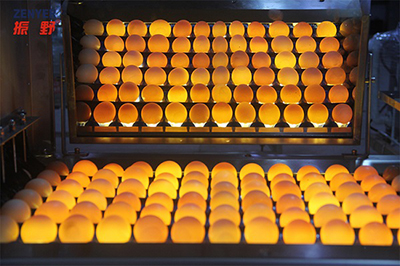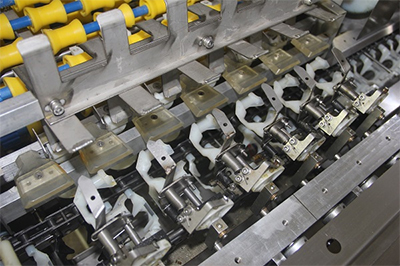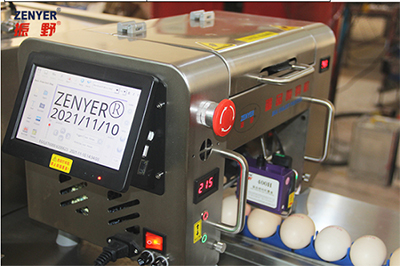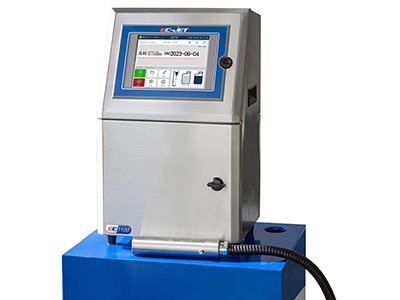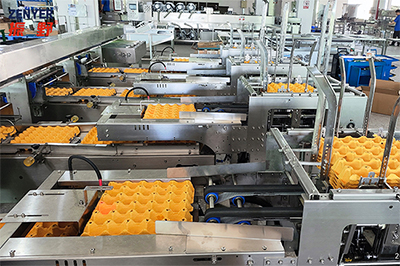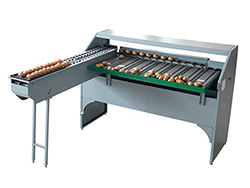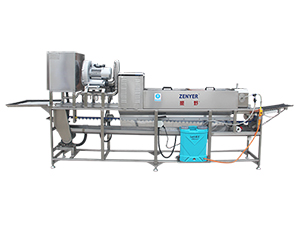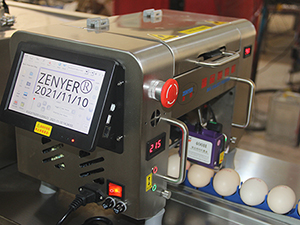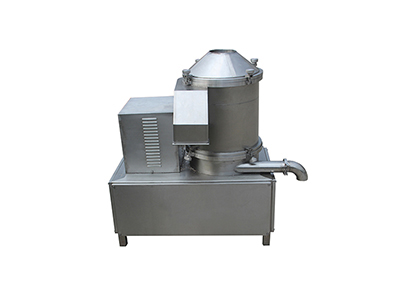- Home
- Products
- Egg Processing Line
- 305A Egg Processing Line
305A Egg Processing Line with Cleaning & Grading (60,000 EGGS/HOUR)
The 305A egg processing line consists of the 205A egg washer and the 111 egg grader, offering all functions of both modules at a capacity of 60,000 eggs per hour. It includes an egg collection module belt, disinfection spraying system, washing, drying, egg orientation, grading, automatic electronic data report generation, and automatic packaging. Additionally, it features an undergrade egg collection table. Optional features include the 615A automatic egg loader (dual suction heads), connection to a central egg collection conveyor from the poultry house, UV disinfection, inkjet printer, AI, as well as automatic de-nesting and stacking machines.
| Product name | Egg Processing Line |
| Product code | 305A |
| Model | ZYL-JS3-HDS6-8Z |
| Capacity | 60,000 eggs/hour |
| Material | Stainless steel |
| Power * | 59.084 KW |
| Voltage | 380V, 50HZ, 3-phase |
| Dimension (L*W*H) | 17.9*8.44*2 M |
| Net weight * | 3070 KG |
| Gross weight * | 4490 KG |
| Function | Accumulating, sanitizing, washing, drying, accumulating & orientation, candling, grading & data reporting, auto-packing and off-grade table; Optional automatic egg loader, UV disinfection, egg printer and visual AI detector, de-nester and tray stacker |
- Automatic Egg Loader (Double Suction Head)/Connect to the Rod Conveyor(Optional)
- Accumulating
- Sanitizing
- Washing
- Drying
- Accumulating
- Egg Orientation (Optional UV Disinfection)
- Visual AI Detecting (Optional)
- Candling
- Grading & Data Reporting
- Inkjet Printing (Optional)
- Auto Packing
- Auto Tray Denesting (Optional)
- Auto Tray Stacking
- Collection For Undergrade Egg
Located at the front end of the washer, this system is responsible for egg loading and sorting guidance. The loading module belt is divided into two sections: the egg storage area and the sorting area. If the egg belt becomes too full, sensors automatically slow the process to ensure high capacity on the rollers and prevent egg damage. The eggs are sorted into 12 rows and then enter the 12-row cleaning system.
Connect With Egg Accumulating
The system can be directly connected to the central egg collection conveyor from the poultry house, automatically feeding eggs into the accumulating module belt.
If it is not possible to connect to the central egg collection conveyor, the 615A automatic egg loader (dual suction heads) is recommended. Eggs are manually placed on the conveyor (no more than 6 trays per stack), and the egg loader will automatically suck the eggs out of the trays and transfer them to the accumulator's rollers. Empty trays are automatically stacked at the end of the conveyor, and the stacked trays must be manually removed.
This egg cleaning machine features a multi-row cleaning structure with 12 horizontal brushing channels, all sharing a single disinfection spraying system. Before washing, the system can spray eggs with a cleaning or disinfecting detergent (provided by the customer) as needed. The spraying system consists of a filter, a proportional metering pump (DOSER), and a liquid tank / bucket or container. During operation, the cleaning or disinfecting detergent is poured into the container, and by opening the valve, the water flow activates the spraying system. The metering pump extracts 95ml/min from the agent container and injects it into the disinfection spray water pipe. After mixing thoroughly with the tap water (pre-set at the factory but adjustable to various ratios), the system automatically sprays the eggs with a mixture of the detergent and water.
This machine features a multi-row cleaning structure with 12 horizontal brushing channels, using a minimal water consumption of only 450 liters per hour. The eggs are cleaned with soft brushes and warm water. The brush speed can be adjusted depending on the level of dirt on the eggs, reducing shell damage and ensuring the eggs’ quality is maintained. The machine achieves an optimal balance of minimal water usage, maximum cleaning efficiency, and the best possible egg quality.
The specially designed drying system ensures eggs are quickly dried after cleaning. This system combines drying brushes and air nozzles to achieve rapid drying while preventing temperature-related damage to the eggs. The drying effectiveness can reach up to 98% (depending on environmental humidity).
Eggs automatically orient themselves through a specially designed egg orientation device, ensuring that the larger end (air cell) faces up after automatic packaging. This orientation helps extend the storage life of the eggs. Additionally, an optional UV disinfection module is available, which uses UV light to disinfect the eggshells, ensuring the eggs meet higher food safety standards.
The visual AI uses a non-contact design, meaning operators and inspection equipment do not need to physically touch the eggs. The system is equipped with a high-definition camera mounted on top of the inspection device cabinet. The camera captures images of the eggs rotating on the feed rollers. Using near-infrared (NIR) light, advanced image processing techniques, and the latest artificial intelligence (AI) algorithms, the system automatically detects defects in the eggs. Any egg with cracks, hair line crack fractures, stains, or other defects is automatically identified and removed from the processing line, ensuring only high-quality eggs continue through the processing stages.
After the eggs are automatically oriented, they pass into a manual candling station, which consists of two 6-channel light inspection units. LED light strips are installed below the 6 rows of rollers. As the eggs pass over the rollers, the LED light illuminates them, allowing the operator to visually inspect for defects such as broken eggs, misshaped eggs, dirt, or black spots. Defective eggs are manually removed.
This machine is a combination of two sets of 109 egg grader, capable of processing 60,000 eggs per hour. Eggs are sorted into 4–7 weight grades, with a grading accuracy of ±1 gram. Data for each batch, including weight for each grade, the number of eggs per grade, the number of egg cartons and trays, as well as counts of dirty, misshaped, or broken eggs (if the visual AI system is added), are displayed in real-time on the machine’s electronic data spreadsheet. Data for any day can be exported in Excel format for external use. The unique intelligent self-diagnosis function will display the fault cause on the screen when any issue arises, helping users quickly identify and resolve problems. The grading machine is also equipped with Wi-Fi, enabling remote monitoring and diagnostics. In case of software malfunctions, quick repairs can be done online.
This dual-channel egg grading machine requires the installation of two 401H inkjet printers. When weighed eggs pass through the light sensors located below the printers, the printing process is triggered. The inkjet printers can print text, numbers, logos, images, Julian dates, expiration dates, and more.
Two 401Y egg printers can also be installed, and they will work in coordination with the ZENYER electronic grading machine’s PLC control system. The printing content can vary based on the egg’s weight, for example, eggs in Grade 1 will be printed with “C1”, Grade 2 with “C2”, Grade 3 with “C3”, etc.
The standard setup includes 8 automatic packing machines and 1 manual egg collection table. You can adjust the number of packing machines based on your needs. After grading, eggs are automatically allocated to the appropriate packing machines according to system settings. The automatic packing machines support 2*5, 2*6, 3*5, 3*6 egg cartons, and 5*6 egg trays. You can choose from various materials for the trays, including paper, plastic, or foam. Each packing machine is dedicated to a specific weight grade of eggs.
Enables efficient delivery of empty egg trays. A stack of empty trays or egg cartons is placed into the denesting unit. The denester has multiple independent gripping points, ensuring reliable and smooth separation of egg packaging materials. Each egg tray or egg carton is automatically transferred to the empty tray conveyor belt.
The auto tray stacking machine (optional) automatically stacks six egg trays into a standard stack without the need for manual labor. This significantly saves time and effort, making it easy for workers to pack the stacked eggs into boxes.
Any eggs that are not packed automatically are directed to the undergrade egg collection table. This table can be divided into three sections. Eggs that are too large or too small, or eggs that do not meet the grading criteria, will be collected here.
Shenzhen ZENYER Egg Machinery Co., Ltd.
Add.: 136, Jiangshi Road, Matian Street, Guangming District, Shenzhen 518106, China
Tel.: +86-755-26974700 / 26974701
Fax: +86-755-26974358
Email: office@zenyer.cn
WhatsApp: +86-13823737025
Wechat: +8618038158337
+8618018763375

